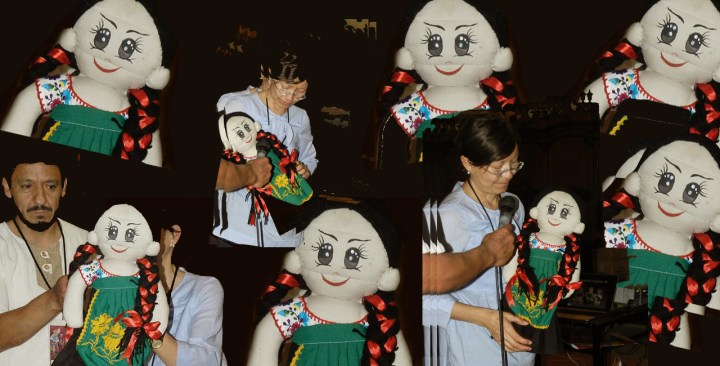Paquitos Are a Family of Dolls That Speak Purépecha, Totonaco, Náhuatl & Wixarica

Art by Alan López for Remezcla
With their braided hair and traditional dress, Paquitos look like the dolls typically seen in mercados de artesanias in Mexico. But really, “Paquitos” are robots that intend to teach children indigenous languages and Spanish. According to Conacyt, Angélica Muñoz Meléndez and Dr. Aurelio López López – researchers at the Instituto Nacional de Astrofísica, Óptica y Electrónica (INAOE) – created five different kinds of dolls that serve as learning tools. “At this point, we have a doll that speaks purépecha, another one that speaks totonaco, a male doll that speaks náhuatl, one [speaks] wixarica, and one more that speaks Spanish.”
The dolls were created in collaboration with the Laboratorio de Lengua y Cultura Víctor Franco (LLCVF) and Centro de Investigaciones y Estudios Superiores en Antropología Social (CIESAS). And they’re meant to be more than just educational. They also give indigenous children an opportunity to see toys that resemble them in some ways.
“Sadly, the toys that exist don’t reflect the lived experience of [indigenous] children,” she said. “There’s a world of difference between these Mexican children and these toys… Our challenge before us was precisely developing educational toys that help Mexican children, and particularly indigenous children, to learn and appreciate their language and culture. We already have a small family of toys that these children can identify with, from the clothes they wear to the language they speak, and we recognize [these toys] as part of the ‘Paquitos’ family.”
Developers have increasingly created apps that teach indigenous languages, but this isn’t always accessible to these populations, according to INAOE. So Muñoz and López took that into consideration when creating Paquitos, which use sensors, data readers, and small modules to record and reproduce audio. The sensors allow the dolls to react to movements on their arms, heads, or legs. That means if you bend the arm of the doll that speaks Spanish, it might say “auch” in response. Because the dolls are actually robots, you can’t expect the same reaction each time.
Muñoz and the team behind the Paquitos have also taken the age of the doll owner into consideration. While a four year old could benefit from a doll that teaches colors and the parts of the body, an older child may find that boring. So the team has also developed Paquitos that are able to play games with children of different age groups. On top of this ambitious project, they also created a worm that speaks hñahñú. The worm helps children construct thousands of simple sentences, like “the mom jumps over the puddle,” according to López López.
So far, there’s no word on when and where the dolls are available. But whenever that time comes, these toys will help fill a void in the toy industry. “In the market, there’s nothing for these children,” Angélica said. “There’s nothing that makes them see how important their language is. There are no toys that represents them or their culture. That’s what we want to convey, that the child can see that there’s interest in their language.”